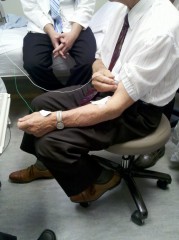The following is a post I wrote for Medscape. It was published on their The Differential blog on January 30, 2009.
*****
I received an email this week regarding an essay contest. The first place winner would receive $1000 and the top three essays would be published in the AAMC’s Academic Medicine. (This is the Gold Foundation’s 2009 Humanism in Medicine Essay Contest.) This year’s essay is to be a reflection on the following quote by Anatole Broyard:
To most physicians, my illness is a routine incident in their rounds, while for me it’s the crisis of my life. I would feel better if I had a doctor who at least perceived this incongruity.
As I read that quote in the email I paused. I thought it simple, yet profound. And although I deleted the email, thinking my chances of winning an essay contest too slim to bother with, I quickly copied the quote and added it to my growing collection (a 41-page Word document consisting of just over 14,000 words).
The idea behind this quote is simple, really. It challenges those of us in (and going into) the medical field to remember what it feels like to be on the other end of the stethoscope — to remember that there is a person and not just a pathogen infecting a host. I remember a course in my freshman year called Understanding Your Patient. The course was not that hard. We talked about teaming with our patients. We talked about how to bring up tough subjects. We tried to learn how to step into their world.
Later in the sophomore year I took another course called Art of Integrative Care. This class challenged us to go deeper into the lives of our patients. The entire quarter was spent investigating and discussing how to practice Whole Person Care by addressing the spiritual health of a patient while we cared for their physical well-being. One assignment for this class sent us into the hospital to interview a patient. We weren’t there to investigate their physical ailment. We were there to get to know the patient, how they were coping with illness, where they found strength, and how (if at all) the illness had affected their belief system. How much more personal can a healthcare provider get than when talking to a patient about their fears and insecurities, their beliefs and doubts, about why bad things happen, and their hopes and their dreams?
What struck me is that this course just ended one month ago, yet the ideas I heard have somehow slipped away from the surface. I attended clinic today at a Pediatrics office. Thinking back, I remember times when I didn’t even bother to consider what the patient was feeling. I walked into the room following the attending, smiled and said hello as I was introduced as the medical student, and listened intently to the patient (or the patient’s mother) as the symptoms and complaints were recalled. My mind raced to form a differential in case I would be asked a question regarding the patient. In that frenzy it became all about the disease. I was desperately intent on meeting and beating the microbe.
But there were also times when the attending walked out of the room to go get something. During one of those times I found myself looking across the room into the eyes of a young patient and her mother. Maybe it was just to avoid an awkward silence. Maybe I didn’t want them to think me totally inept or socially retarded. Or maybe it was that a part of me wanted to connect with the people on the “other side.” Regardless of the reason I, the self-proclaimed king of introverts, spoke up. I engaged the little patient. We talked. She laughed. Her mother smiled. She told me that her mother had lots of sisters but she only liked one. She giggled. Her mother laughed. I chuckled.
We all left the room knowing what the diagnosis was and what the treatment would be. More importantly, I left the room knowing that I had met the patient and not just the disease.











